Slip and Fall Attorney Los Angeles | Recover Damages
Slip and fall accidents can turn your world upside down, physically, emotionally, and financially. From painful injuries and lost wages to mounting medical bills, the aftermath is often overwhelming. If your fall was caused by someone else’s negligence, you shouldn’t have to bear the burden alone. At Blair & Ramirez LLP, we provide trusted, local legal support for Los Angeles residents dealing with life-altering accidents. Our experienced attorneys have a strong track record of holding property owners accountable and securing maximum compensation for our clients.
What Qualifies as a Slip and Fall Accident in Los Angeles?
Under California’s premises liability law, slip and fall accidents happen when a property owner fails to maintain a safe environment and someone gets hurt because of it. These accidents are not just clumsy moments; they are often the result of subpar upkeep or even outright negligence.
A slip and fall case typically involves unsafe property conditions, such as:
- Wet or slippery floors with no warning signs
- Uneven sidewalks or broken pavement
- Poor lighting in stairwells or walkways
- Cluttered or unmaintained spaces
To have a valid claim, you must prove:
- The property owner knew or should have known about the hazard.
- They failed to fix or warn about it in a reasonable time.
- That negligence directly caused your injury.
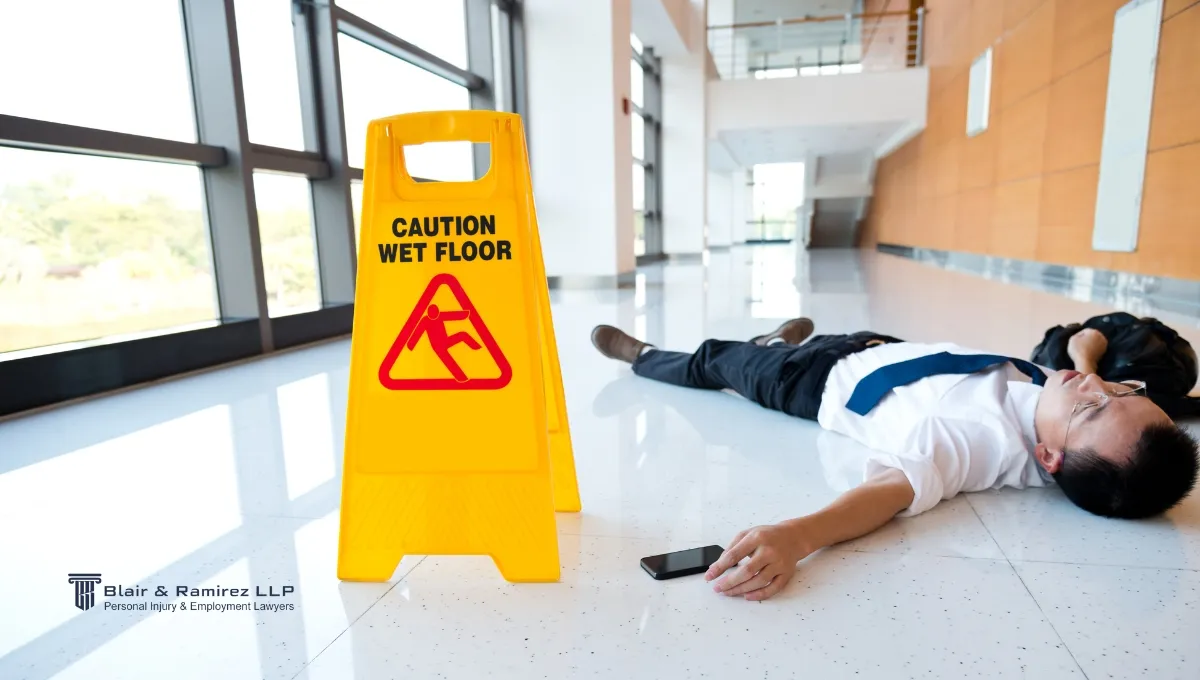
Who Can Be Held Responsible for a Slip and Fall Injury?
When a slip and fall occurs, one of the first legal questions is: Who is liable? The answer often depends on the type of property and who is responsible for maintaining it. In California, liability can extend to multiple parties, including:
- Property owners – Responsible for the overall safety of the premises.
- Landlords – May be liable for common areas like hallways, staircases, or parking lots.
- Business owners or tenants – Often accountable for keeping their leased spaces hazard-free.
- Management companies – If contracted to oversee property maintenance, they can be held responsible for unsafe conditions.
Public properties like sidewalks or parks may involve government entities, while private or commercial properties typically fall under the responsibility of owners, tenants, or third-party managers.
Determining who had control over the hazardous condition is key to assigning legal fault, something an experienced attorney can investigate through records, contracts, and incident details.
What If More Than One Party Is at Fault?
Slip and fall cases aren’t always black and white. In many situations, both the injured person and the property owner may share some responsibility. That is where California’s comparative negligence rule comes into play.
Under this law, fault is divided between all parties involved. If you are found partially responsible for your fall, say, you were looking at your phone or ignored a warning sign, your compensation may be reduced by your percentage of fault.
For example:
If the California court awards you $100,000 in damages but also declares you to be 20% at fault, you would still receive $80,000.
This rule ensures a fairer outcome but also makes it critical to have strong legal representation, to minimize your share of the blame and maximize your recovery amount.
Common Multi-Party Responsibility Scenarios
Slip and fall cases often involve more than one potentially responsible party. Depending on the property and how it is managed, liability can be shared or disputed among several entities.
Understanding who is accountable is key to building a strong case, which is where working with the best slip and fall attorney in Los Angeles can make all the difference. Here are some common examples:
Landlord vs. Tenant
If a tenant rents a commercial space, like a restaurant or retail shop, they are usually responsible for maintaining the interior of the premises. However, the landlord may be liable for hazards in shared areas, like parking lots or stairwells.
Example: A customer slips on a broken step in a building's common stairway. The landlord, not the business owner, may be held responsible.
Management Company vs. Property Owner
Property owners often hire management companies to handle day-to-day maintenance. If a fall occurs due to neglected upkeep, the management company may be held liable.
Example: A visitor slips on a leaking pipe in a hallway. If the management company ignored repair requests, they could share or bear full responsibility.
Each party’s level of control and contractual duty determines their legal accountability, something your attorney will investigate closely.
Recent Cases We've Won
How Do You Prove Negligence in a Slip and Fall Case?
To win a slip and fall case in California, it is not enough to simply show that you were injured, you need to prove that someone else’s negligence caused it. That means building a strong case supported by facts, details, and evidence.
Legally, four key elements must be established:
- Duty of Care – The property owner or responsible party had a legal obligation to keep the area safe.
- Breach of Duty – They failed to uphold that duty (e.g., ignoring a known hazard).
- Causation – That breach directly caused your fall and injury.
- Damages – You suffered real losses, such as medical bills, lost wages, or pain and suffering.
Expert Testimony and Third-Party Reports
In more complex slip and fall cases, expert testimony can be critical to proving liability and validating your injuries. These professionals offer objective, specialized insight that supports your claim with authority.
Common experts include:
- Engineers or safety inspectors – Can analyze building codes, flooring materials, lighting levels, or structural defects to show how the hazard violated safety standards.
- Medical experts – Help link your injuries directly to the fall and explain the severity, long-term effects, and treatment required.
- Accident reconstruction specialists – Use physics, measurements, and data to recreate the incident and demonstrate how it occurred.
- Industry experts – Can speak to what a “reasonably careful” property owner or business would have done under similar circumstances.
These third-party reports and testimonies can strengthen your case by providing clarity, credibility, and context, especially when the property owner disputes fault.
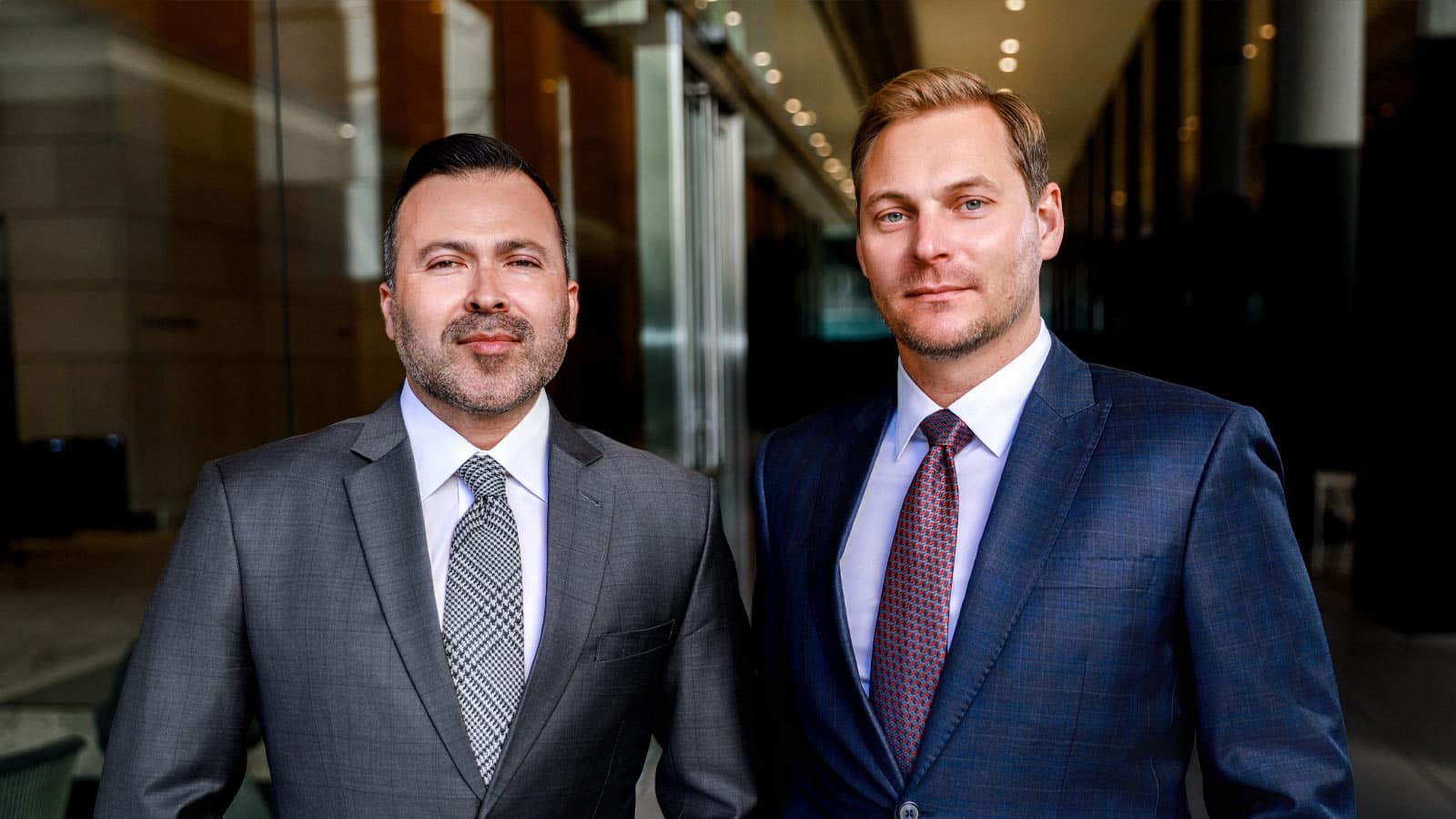
We're here to help.
"Assessing a slip-and-fall claim is challenging, given the many premiss situations . Let us answer your questions - it's free!"
- Do I have a claim?
- How much is it worth?
- What do I do next?
What Should I Do After a Slip and Fall Accident?
What you do in the moments and days after a slip and fall can significantly impact both your recovery and your ability to pursue compensation. Taking the right steps early on helps protect your health and strengthens your legal claim.
Here’s why it matters: waiting too long to seek medical help, report the incident, or document evidence can make it harder to prove negligence later. Insurance companies and property owners often look for gaps or inconsistencies to challenge your case.
Even if your injuries seem minor at first, some injuries like soft-tissue damage or head trauma can worsen over time. That’s why it is of paramount importance to get checked out by a doctor, then afterward consult a slip and fall accident attorney in Los Angeles who understands how these cases are fought and won.
Seek Medical Attention Right Away
Get checked immediately, even if you feel okay. Go to the ER, urgent care, or your primary doctor the same day. Falls often cause injuries like concussions, soft tissue damage, or fractures that don’t show symptoms right away.
Document the Scene
Use your phone to take pictures or video of the exact location where you fell. Capture the hazard, the surroundings, and the lighting conditions. Make sure to photograph signs, or the lack of them.
Gather Witness Information
Speak to anyone who saw you fall or saw the hazard. Get names, phone numbers, and a brief description of what they observed. Even if they didn’t see the fall, their knowledge of the unsafe condition can be powerful.
Report the incident
Tell the property owner, store manager, landlord, or security staff right away. Request to file an incident report and ask for a copy. If they won’t give you one, write down their name, title, and what was discussed.
Each of these steps helps preserve key evidence and protect your legal rights while your claim is being evaluated.
When to Contact a Slip and Fall Accident Attorney
You do not and should not have to wait until things get complicated to speak with a lawyer. The best time to contact a slip and fall accident attorney is as soon as possible, ideally right after the incident or once you are medically stable.
Early legal guidance helps protect your rights and ensures that you don’t make silly mistakes that could hurt your case later on.
Waiting too long can lead to:
- Lost or destroyed evidence – Surveillance footage, hazard cleanup, or fading witness memories can all weaken your case.
- Lowball insurance offers – Insurance companies may pressure you to settle quickly before you know the full extent of your injuries.
- Missed legal deadlines – In California, you generally have two years to file a personal injury claim, but some cases (like those involving government property) have much shorter timeframes.
Speaking with an attorney early gives you the best chance at recovering full and fair compensation without the added stress of navigating the legal system alone.
Mistakes to Avoid After a Slip and Fall
In the stressful moments after a slip and fall, it is easy to make decisions that can unintentionally hurt your case. Avoiding these common missteps can protect your health and your ability to recover compensation:
- Admitting fault or apologizing – Even casual remarks can be used against you later. Stick to the facts and avoid making assumptions.
- Neglecting medical care – Delaying treatment can weaken the link between the fall and your injuries. Always get checked out, even if you feel okay.
- Failing to report the incident – If there is no formal report filed, property owners may deny the fall ever happened. Always report it immediately.
- Not gathering evidence – Without photos, witness info, or notes from the scene, it becomes harder to prove negligence.
- Talking to insurance adjusters without legal advice – They may try to get a statement or push a quick (and low) settlement.
- Accepting a lowball offer – Once you settle, you usually cannot go back to retry your case and/or ask for more money, even if your injuries worsen or new expenses arise.
Types of Compensation You May Be Eligible For
If you have been injured in a slip and fall accident, knowing what compensation is available is a key step in protecting your future. Depending on the severity of your injuries and the circumstances of the case, you may be entitled to several forms of damages.
A skilled slip and fall injury attorney in Los Angeles can help you pursue:
Economic Damages: Medical Bills and Lost Wages
After a serious slip and fall, the financial impact can be immediate and overwhelming. Economic damages aim to cover the real, measurable losses you've suffered most commonly through medical costs and lost income.
Medical Costs (Slip and Fall)
Even a single fall can lead to costly medical treatment. You may be eligible to recover compensation for:
- Emergency room visits and ambulance fees
- Diagnostic tests like X-rays, MRIs, or CT scans
- Follow-up care including doctor visits and specialist consultations
- Surgery or hospitalization if required
- Prescription medications and physical therapy
- Medical equipment (crutches, braces, wheelchairs)
Lost Wages
If your injuries force you to take time off work or prevent you from returning at full capacity, you may be entitled to:
- Lost income from missed workdays
- Reduced earning capacity if you cannot return to your previous job
- Future lost wages in long-term or permanent injury cases
An experienced attorney will help calculate the full scope of your losses to ensure that you are not left covering expenses that someone else’s negligence caused.

Non-Economic Damages: Pain and Suffering
Not all injuries are visible in many slip and fall cases, the emotional and physical impact can linger long after the bruises and broken bones heal. These non-economic damages compensate you for the suffering that is not able to be measured in receipts or pay stubs.
Pain and Suffering (Slip and Fall)
This includes both physical discomfort and emotional distress you endured as a result of the accident:
- Chronic pain from fractures, nerve damage, or long-term injuries
- Psychological trauma, including anxiety, depression, or PTSD
- Sleep disturbances, mood changes, and loss of mental well-being
- Permanent disfigurement or scarring that affects your self-esteem
- Loss of enjoyment of life due to physical limitations or emotional hardship
While these damages are harder to quantify, they are just as real and important. A qualified attorney will work to demonstrate the full extent of your suffering and fight for the compensation you deserve.
Punitive Damages in Severe Negligence Cases
In most slip and fall claims, the goal is to recover compensation for your injuries and losses. But in rare cases involving gross negligence or intentional misconduct, the court may also award punitive damages, which is a financial penalty designed to punish the wrongdoer and deter similar behavior.
When Do Punitive Damages Apply?
You may be eligible for punitive damages in slip and fall cases if the property owner or responsible party:
- Ignored repeated safety violations
- Knew about a serious hazard and intentionally failed to fix it
- Showed reckless disregard for the safety of others
- Tried to cover up the incident or destroy evidence
These damages go beyond basic compensation and reflect the severity of the negligence involved. Though not awarded in every case, they can significantly increase the value of your claim when justified.
Factors That Influence Case Value
Every slip and fall case is unique, and the potential compensation can vary widely. Several important factors will determine how much your case is worth and how aggressively the other side may fight back.
A skilled slip, trip and fall accident attorney will evaluate the following key variables:
- Severity of Injury
More serious injuries like broken bones, spinal damage, or traumatic brain injuries typically result in higher settlements. - Permanency and Long-Term Impact
If your injuries lead to a long-term or permanent disability, your case value increases to reflect future care, pain, and loss of function. - Total Medical Costs
Emergency treatment, surgeries, rehabilitation, prescriptions, and ongoing care all contribute to the economic damages in your claim. - Clarity of Liability
Strong, clear evidence that the property owner was negligent makes your case more likely to succeed and more valuable in negotiations. - Lost Wages and Earning Capacity
If the injury affects your ability to work now or in the future, those financial losses are factored into your settlement amount request. - Insurance Policy Limits
The defendant’s available coverage can cap how much compensation is realistically recoverable, even in strong cases.
Understanding how these elements shape your case is critical, and the right legal team can help maximize every dollar you're owed.
Average Settlement for Slip and Fall Case
One of the most common questions we hear is: “What is my slip and fall case worth?” The truth is, every case is unique, and settlement amounts can vary based on the specifics of your injury and the circumstances of the fall.
While every case is different, typical settlement ranges look like this:
Minor injuries (sprains, bruises, soft tissue damage):
$10,000 – $30,000
Moderate injuries (fractures, concussions, short-term disability):
$30,000 – $100,000
Severe injuries (spinal trauma, head injuries, permanent disability):
$100,000 – $500,000+
These numbers are influenced by several factors, including:
- Medical bills and expected future care
- Time off work and lost earning potential
- Pain, suffering, and emotional distress
- Clarity of liability and available insurance coverage
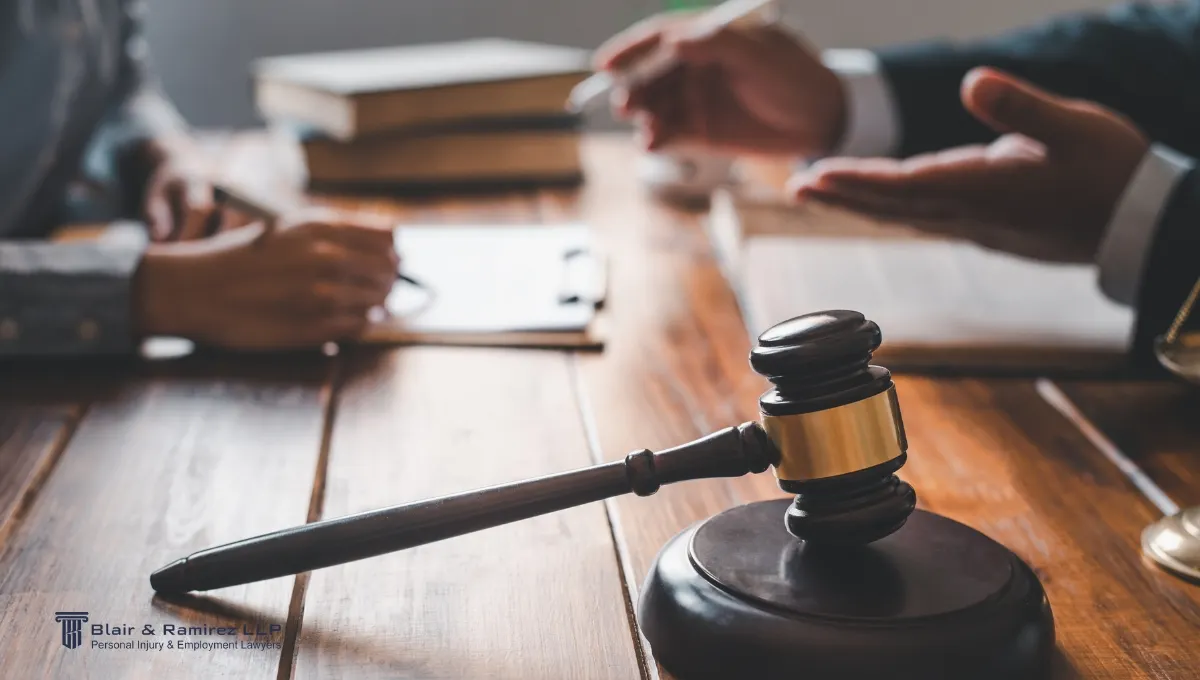
Statute of Limitations for a Slip and Fall Claim in California?
Understanding the legal timeframes in California slip and fall cases is crucial, because missing a deadline could mean losing your right to compensation entirely. That’s why it is essential to act quickly and consult with a qualified slip and fall attorney in Los Angeles, CA.
Here are the key deadlines to know:
- You have 2 years from the date of the injury to file a personal injury lawsuit.
(California Code of Civil Procedure §335.1) - If the fall occurred on government property, you must file a claim within 6 months of the incident.
These time limits apply whether your injuries seem minor or severe, and the clock starts ticking the day the accident happens.
Exceptions to Standard Statute of Limitations
While most slip and fall cases in California must be filed within 2 years, there are specific exceptions where the clock may be extended. These are especially important in cases involving vulnerable individuals or delayed injury discovery. These are:
- Minors (under 18 years old)
The 2-year clock does not start until the child turns 18. This gives them until age 20 to file a claim. - Mentally incapacitated individuals
If the injured person is legally incapacitated at the time of the fall, the statute may be paused (or "tolled") until they regain legal capacity. - Delayed discovery of injuries
In some cases, injuries from a fall may not be immediately apparent. The statute may begin from the date the injury was discovered or reasonably should have been discovered. - Fraud or concealment
If a property owner deliberately concealed the hazard or misled the victim, the statute may be extended based on when the fraud was uncovered.
Each of these exceptions involves complex legal nuances, so it is critical to consult with an attorney as soon as possible to avoid missing key deadlines.
What Happens If You Miss the Deadline?
If you miss the legal deadline to file a slip and fall claim in California, your right to seek compensation may be permanently lost. Courts are strict about the statute of limitations, and very few exceptions apply.
Don’t risk losing the chance to recover damages for your injuries, medical costs, and lost wages.
If you believe time may be running out, contact an experienced slip and fall attorney. A lawyer can quickly review your case, confirm deadlines, and take fast action to protect your rights.
Don’t wait, your window to file may already be closing. Reach out to Blair & Ramirez LLP today for a free consultation.
Why Hiring a Local Los Angeles Attorney Matters
When it comes to building a strong slip and fall claim, hiring an attorney with local expertise can be a game-changer. A lawyer who understands Los Angeles property laws, court procedures, and city-specific liability issues is better equipped to navigate your case quickly and effectively.
An experienced slip and fall negligence attorney brings key advantages, including:
- Familiarity with local courts and judges, which helps in anticipating how a case might be handled
- Knowledge of LA-specific ordinances—like sidewalk maintenance responsibilities, commercial zoning regulations, and building code enforcement
- Understanding of neighborhood liability trends, such as recurring safety complaints in certain business districts or public areas
- Easier access to local investigators, inspectors, and expert witnesses who can strengthen your case fast
Hiring an LA attorney builds stronger claims and often results in faster case resolution and better settlement outcomes.
If you’ve been injured in a fall, don’t leave your case to chance. Work with someone who knows the City of Angels and how to win here.
Why Choose Our Lawyers For Your Case?
When you’re facing the aftermath of a serious fall, you need more than just legal help—you need proven, powerful legal representation. At Blair & Ramirez LLP, we bring deep experience, personal attention, and a track record of winning results in even the toughest of slip and fall cases.
Whether you slipped in a grocery aisle at the Hollywood Erewhon or fell on a poorly maintained sidewalk outside the Santa Monica Trader Joe’s, our LA-based team is here to fight for you. As a leading grocery store slip and fall attorney in Los Angeles, here is what sets us apart:
- 96% Trial Success Rate – We fight hard and win big for our clients
- Over $100 Million Recovered – Results that speak for themselves
- Recognized as a ‘Top 40 Under 40’ Legal Firm – Trusted by peers, respected by judges and litigators in Los Angeles County courts
- Skilled in Complex Injury Cases – Including brain injuries, surgeries, and long-term disabilities
- Truly Personalized Representation – You will never be treated like just another faceless case file
- Bilingual Staff – Fluent in English and Spanish, making communication easy and clear
- No Win, No Fee – You pay nothing unless we win your case
From your first consultation to final settlement, we’ll be right by your side, ready to protect your rights and pursue the compensation you deserve.
Ready to Talk to a Slip and Fall Lawyer?
You’ve been through enough. Let us take it from here.
At Blair & Ramirez LLP, we understand the physical, emotional, and financial stress that follows a serious fall. That’s why we offer compassionate, experienced legal support, with no fees unless we win your case.
- You focus on healing, we’ll handle the rest
- Free, no-obligation case review available 24/7
- You will speak not with lower level staff, but directly with a trusted and proven slip and fall accident attorney in Los Angeles
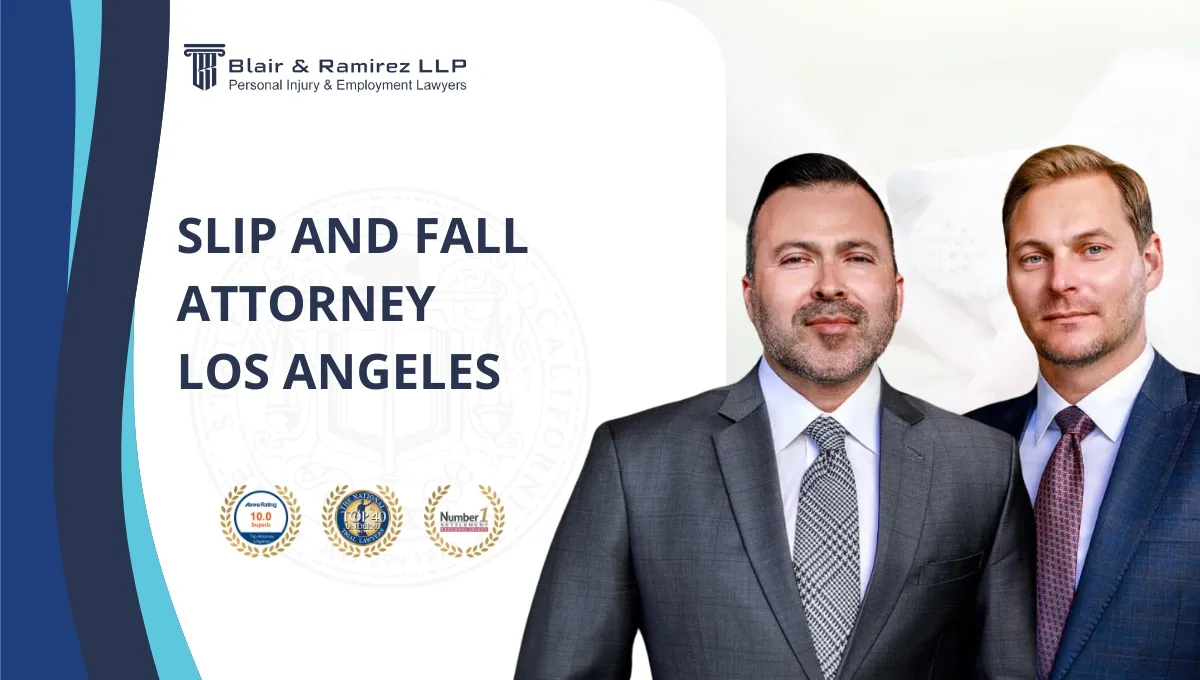
Contact us today to schedule your free consultation. There’s no pressure, just quick and complete answers.
Key Legal and Safety Factors in Los Angeles Slip and Fall Cases
If you’ve been injured in a fall, understanding the legal and safety dynamics unique to Los Angeles is an important first step. From uneven sidewalks and poorly lit stairwells to negligent property management, many hazards are governed by specific local codes and liability standards.
These cases are not just about proving you fell, they are about demonstrating who was responsible, what safety measures were (or were not) in place, and how the law protects you.
Laws Related to Slip and Fall Cases
If you were recently hurt in a fall, it is important to learn your legal rights and that starts with understanding the specific laws and regulations that apply to your case. California has specific statutes and legal doctrines that protect injury victims and outline when property owners can be held responsible.
Here are the key laws that matter in slip and fall claims:
California Civil Code §1714 – General Duty of Care
This law states that everyone is responsible for their actions and must take reasonable care to avoid harming others. For property owners, this means they must maintain safe conditions and warn about known dangers.
California Code of Civil Procedure §335.1 – Statute of Limitations
This sets the legal deadline for filing a personal injury lawsuit. In most cases, you have two years from the date of the injury to file a claim. Missing this deadline can mean losing your right to compensation.
Premises Liability Doctrine
This legal principle holds property owners (or those in control of a property) responsible if someone is injured due to dangerous conditions they knew or should have known about. This applies to:
- Businesses (e.g., slippery grocery store floors)
- Private property (e.g., broken stairs in an apartment complex)
- Public property (e.g., uneven sidewalks)
Duties of Los Angeles Property Owners to Prevent Slip and Fall Accidents
Property owners in Los Angeles have a legal duty to maintain safe premises for guests, tenants, customers, and the general public. When they fail to meet this obligation, they may be held liable for any injuries that occur as a result.
Understanding these duties is crucial if you have recently been injured, because proving a breach in these responsibilities is a key part of any sound claim. Here are the primary responsibilities property owners must uphold:
- Regular Inspections
Owners must routinely inspect their property to identify hazards like broken steps, wet floors, or loose handrails, before someone gets hurt. - Timely Repairs
Once a dangerous condition is discovered, it must be repaired promptly. Delayed maintenance can quickly lead to liability if an injury occurs. - Proper Signage
If a hazard cannot be fixed right away (like a spill or freshly mopped floor), owners must post clear warning signs to alert visitors and prevent accidents. - Addressing Known Hazards
Owners are responsible for correcting both known dangers and those they should have known about through reasonable care.
These standards apply across different types of property:
- Residential properties (e.g. landlords must keep walkways and stairs safe)
- Commercial spaces (e.g. stores and offices must prevent tripping or slipping hazards for customers)
- Government-owned property (e.g. city sidewalks and public buildings must meet safety codes, though special rules apply)
Failing to meet these duties isn’t just careless, it can be grounds for a legal claim.
Common Hazards That Lead to Falls
Whether inside a building or outside on public or private property, slip and fall accidents are often caused by preventable hazards. Here are some of the most common dangers, grouped by location:
Indoor Hazards
- Spilled liquids or freshly mopped floors with no warning signs
- Loose or torn carpeting and rugs
- Slippery tile or wood flooring
- Broken or missing handrails on stairs
- Cluttered walkways or merchandise left in aisles
- Poor lighting in stairwells, hallways, or entrances
Outdoor Hazards
- Uneven or cracked sidewalks and concrete pathways
- Potholes or unmarked changes in ground elevation
- Rain-soaked entrances without non-slip mats
- Debris or trash obstructing walkways
- Inadequate outdoor lighting in parking lots or entrances
- Ice or algae-covered surfaces (especially near sprinklers or poorly drained areas)
When property owners fail to address these risks, they put others in danger and may be held legally responsible for resulting injuries.
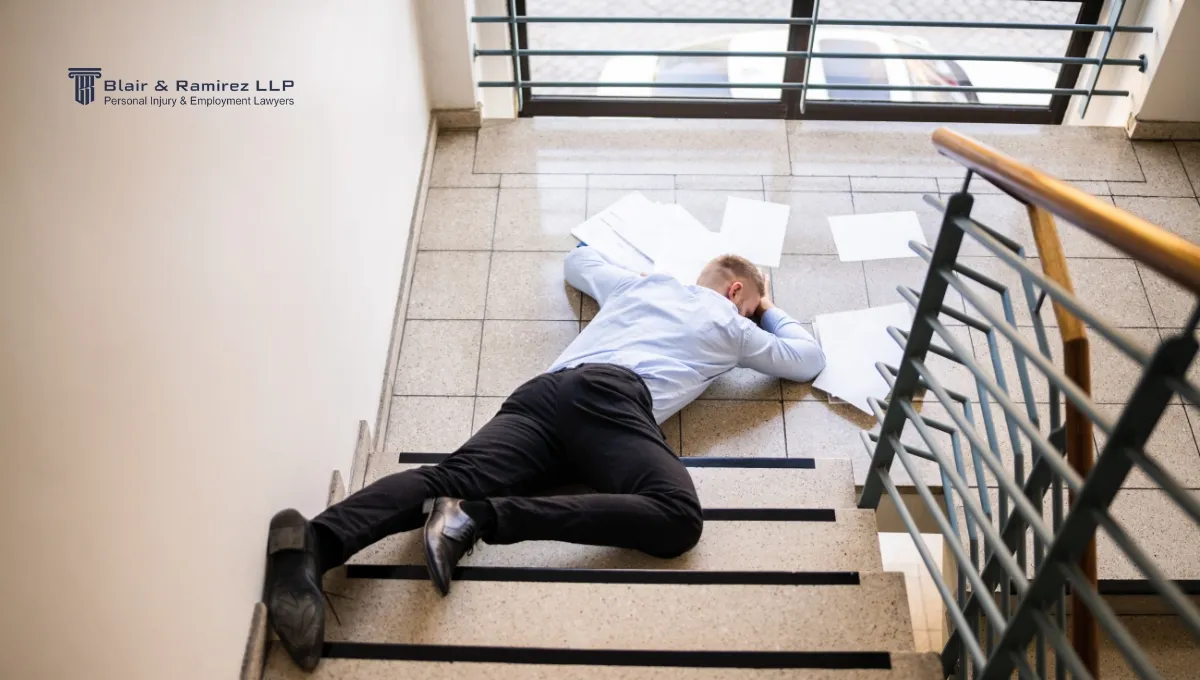
Common Injuries Sustained in Slip and Fall Accidents
Slip and fall accidents can cause far more than a momentary scare; they can result in serious, life-altering injuries, especially when they happen on hard surfaces like concrete or black ice. The nature and severity of your injury can significantly affect your recovery time, quality of life, and legal case value.
Here are some of the most common injuries caused by falls:
- Fractures and broken bones – Especially common in wrists, ankles, hips, and ribs
- Concussions and brain trauma – Even mild head injuries can lead to long-term cognitive or emotional issues
- Spinal injuries – Including herniated discs, nerve damage, or even partial paralysis in severe cases
- Dislocations – Often affecting shoulders, knees, or fingers during the impact of a fall
- Soft tissue injuries – Sprains, strains, and ligament tears that can require extensive therapy
- Cuts and bruises – Though sometimes minor, deep lacerations or facial injuries can cause scarring or require surgery
Long-Term Effects
- Chronic pain that persists long after the initial injury
- Reduced mobility or range of motion
- Ongoing medical treatment and physical therapy
- Permanent disability or decreased independence
Can I still file a claim if the fall happened in a public place in Los Angeles?
Yes, you can still file a claim if your fall occurred in a government-managed public place in Los Angeles, but there are special rules and much shorter deadlines when a federal, state, or municipal entity is involved.
If your injury took place on city-, county-, or state-owned property, your case may fall under California’s Government Claims Act, which requires:
- Filing a formal claim within just 6 months of the incident
- Submitting the claim to the correct government agency (e.g., City of Los Angeles, LA Metro)
- Waiting for a response and acknowledgement of receipt before you are allowed to proceed with filing a lawsuit
Examples of public places where slip and fall accidents commonly happen include:
- Sidewalks and crosswalks with uneven pavement or cracks
- Public parks with poorly maintained walkways or restrooms
- Libraries, recreation centers, and other city-owned buildings
- Public transit stations, such as Metro bus stops or train platforms
- Courthouses and DMV offices with slippery floors or poor lighting
Because the rules and timelines are strict, it's important to act fast.
Will my immigration status affect my ability to file a claim in Los Angeles?
No, your immigration status does NOT affect your right to file a personal injury claim in California. Whether you are undocumented, on a visa, or a permanent resident, you are legally protected under California law if you have been injured due to someone else’s negligence.
This includes slip and fall accidents on:
- Private property (e.g., businesses, apartment complexes)
- Government property (e.g., public parks, sidewalks, transit stations)
California courts do not require you to prove citizenship or immigration status to pursue compensation for your injuries. In fact, it is illegal for a defendant or insurance company to deny your claim or reduce your compensation based on your immigration status.
Final Thoughts: Your Rights After a Slip and Fall in Los Angeles
Understanding your legal rights after a slip and fall in Los Angeles is crucial to ensuring you receive the full compensation you deserve. From knowing the deadlines to understanding who may be held responsible, being more informed gives you the best chance at achieving a successful claim.
Remember, your immigration status or location in the city will not impact your ability to seek justice.
Whether your injury occurred in a private business, on government property, or at an acquaintance’s home, legal help is always available to guide you, no matter your situation. You don’t have to navigate this process alone.
If you’ve been hurt, reach out for advice and support. Our experienced, compassionate team at Blair & Ramirez is here to help you understand your rights and pursue the compensation you deserve.
Call Us 24/7
(213) 568-4000

